|
It is a dark and stormy night . . .
|
US / 61 minutes / bw / Sigmund Neufeld Productions, PRC Dir: Sam Newfield Pr: Sigmund Neufeld Scr: Fred Myton Cine: Robert Cline Cast: George Zucco, Noel Madison, Byron Foulger, Robert Middlemass, Charlie Middleton, Robt. Randall, Wanda McKay, Glenn Strange, I. Stanford Jolley.
Years ago Amos Bradford (Zucco) was a criminal mastermind known as The Black Raven. Now he runs a remote inn, also called The Black Raven, somewhere near the border with Canada. Tonight a stranger arrives, Whitey Cole (Jolley)—although he’s no stranger to Amos, but the partner he left to carry the can when he evaded the cops one final time before assuming the mantle of respectability. Whitey’s escaped from the pen with ten years of his sentence still to go. Now he wants to settle up with Amos one last time . . .
Whitey Cole (I. Stanford Jolley) arrives on the scene.
But then Amos’s dimwit handyman, Andy (Strange), bursts in out of the howling gale, and between the two of them Amos and Andy (yes, really) subdue Whitey:
Andy: “What was the matter? Didn’t he like the service?”
Amos: “He’s suffering from rabid delusions aggravated by a moronic mentality.”
Andy: “Is that bad?”
Other guests arrive seeking shelter from the storm, all of them in one way or another relying on the inn’s reputation as the last stopping point on the way to refuge in Canada. First to arrive is gangster Mike Bardoni (Madison)—his name spelled “Baroni” in a newspaper headline we see, but that’s B-movies for you. He knows of Amos’s past as The Black Raven and wants his aid in sneaking across the border; his organization has been taken over by political and criminal Mr. Big, Tim Winfield, who reckons Bardoni is expendable.
Bardoni (Noel Madison) thinks he’s on top of the situation.
Oops.
Next comes a dapper little guy who, like Bardoni, signs his name in the inn’s register as John Smith. In fact, as we soon learn, he’s bank clerk Horace Weatherby (Foulger), on the run bearing a satchel with $50,000’s of embezzled loot in it and planning to use the ill gotten gains to make a new life for himself in Canada.
Byron Foulger as runaway bank clerk Horace Weatherby.
A little later he gives an explanation for his crime which exemplifies the fact that this movie—despite a few tedious breaks for unfunny clowning, as was a PRC tic—has a screenplay that’s really a cut above its budget:
Horace: “This is my last and only chance to live and I won’t give it up. All my life I’ve been nothing but an animated adding machine. I wasn’t supposed to have any feelings or any emotions. They just wound me up once a week with that little salary check that was supposed to make me tick until the next Saturday. And, traveling back and forth to work in that crowded subway with its smell of sweat and garlic, all I could think of was fresh air and the out-of-doors . . .”
Horace is quite obviously gay, a fact that’s alluded to in a couple of jokes, but the jokes are so gently done that it’s hard to take much offense at them—they’re teasing rather than homophobic.
George Zucco as supposedly reformed Amos Bradford.
After Horace come eloping couple Allen Bentley (Randall) and Lee Winfield (McKay). They’re heading for Canada because Lee’s domineering father Tim Winfield—the very same hoodlum from whom Bardoni’s fleeing—refuses to countenance the marriage of his daughter to a loathsomely honest fellow like Allen. By coincidence, Winfield’s car has broken down a half-mile or so from The Black Raven, and so Winfield himself (Middlemass) is the last of the night’s guests to arrive.
After having been obnoxious to everyone—notably Allen, whom he plans to charge with kidnap because Lee is just shy of her 21st birthday—and having coaxed the $50,000 out of Horace under the pretense he’ll give it back to the bank from which it was embezzled, Winfield is the first person to get bumped off, his brains bashed in with a blunt instrument. Eventually the Sheriff (Middleton) arrives on the scene; at least as dim as Andy (most of PRC’s cops were dim, in the deluded belief that this was funny), the Sheriff assumes Allen is the murderer and does his best to stitch him up.
Winfield (Robert Middlemass) persuades Horace (Byron Foulger) to hand over the stolen money.
There’s to be more murder before the dark and stormy night is over, at least in part because Whitey Cole has escaped the knots with which Andy and Amos tied him and is prowling around, still in quest of that elusive revenge. It also becomes plain that, despite his criminal past and his somewhat dodgy present, Amos Bradford has a great deal of integrity: even at the cost of losing his hold on any part of the $50,000, he faces down the Sheriff, who’s keen to arrest and condemn an innocent man.
Amos Bradford (George Zucco) confronts the bumbling Sheriff (Charlie Middleton).
This is a very minor outing indeed, yet I couldn’t help but like it. George Zucco’s always worth watching, as are Noel Madison and Robert Randall. Wanda McKay, who plays the toothsome Lee Winfield, was an interesting character. Born Dorothy Quackenbush, she was first and foremost a model of some distinction. Paramount signed her up by the start of World War II, but most of her long but less than sparkling screen career was spent starring in B-movies like, well, this one. She was married briefly in the early 1940s, but thereafter remained single until 1977, when she married the great jazz musician and composer Hoagy Carmichael for what proved to be the last few years of his life; he died in 1981. She died in 1996, aged 80. You can find out much more about her here.
As noted, Fred Myton’s screenplay for The Black Raven has higher high points than you’d expect—what’s a nice turn of phrase doing in a movie like this?—and the same could be said of Robert Cline’s cinematography. Cline made great use of shadows and intermittent lighting in this movie, arguably too much so and often rather cheesily, but at least as frequently to great effect.
One example of cinematographer Robert Cline’s dynamic use of shadows to tell a story.
======
Each month Rich Westlake at his Past Offences blog selects a year for special treatment, and February’s year is 1943. This is a contribution toward that venture.
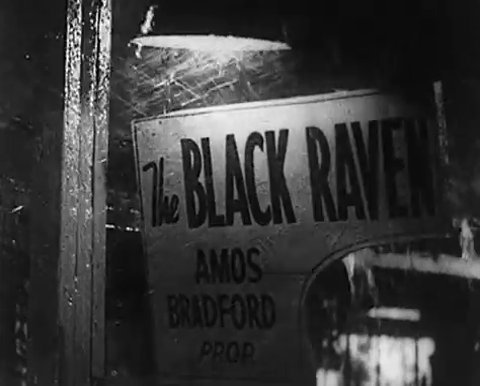
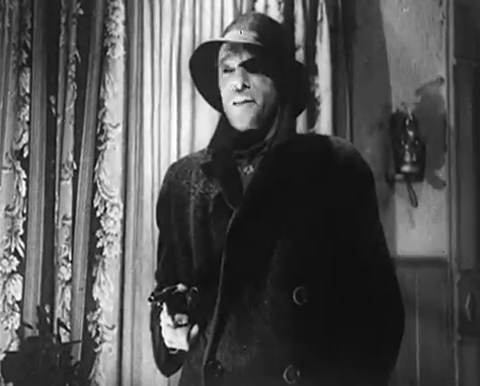
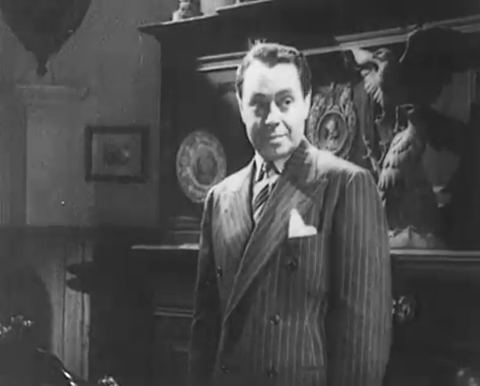
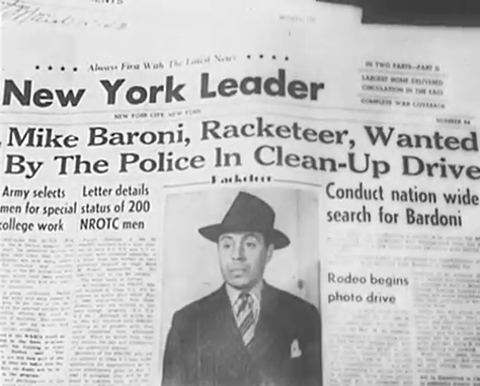
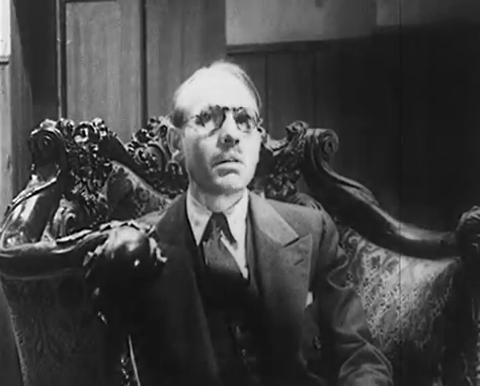
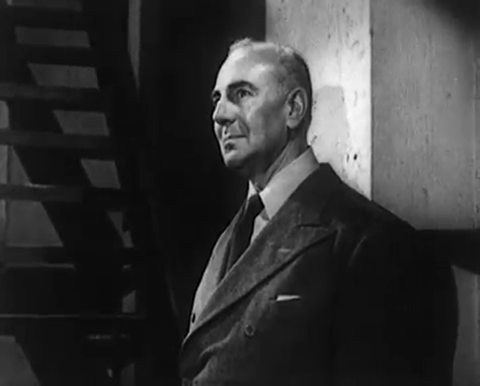
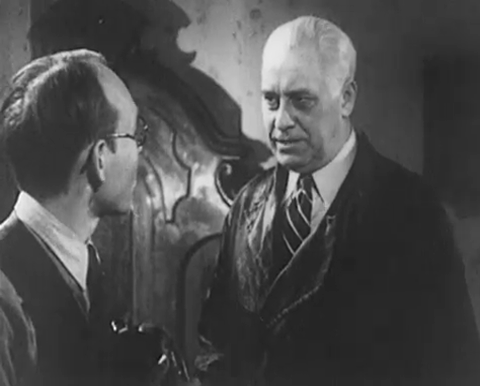
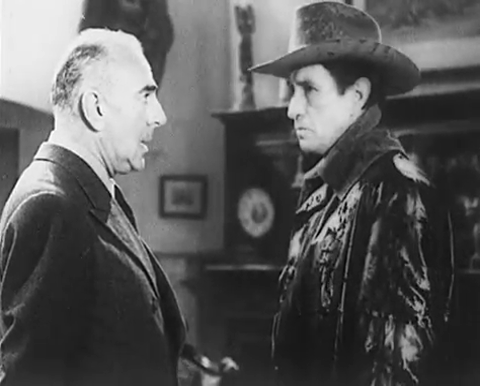
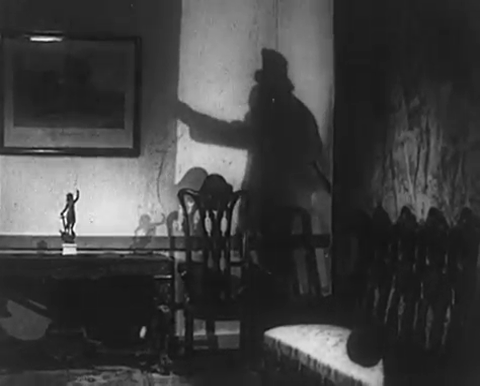
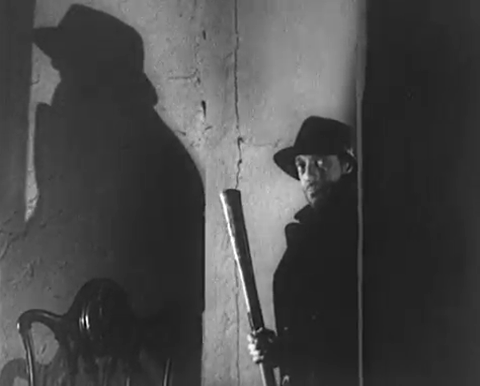
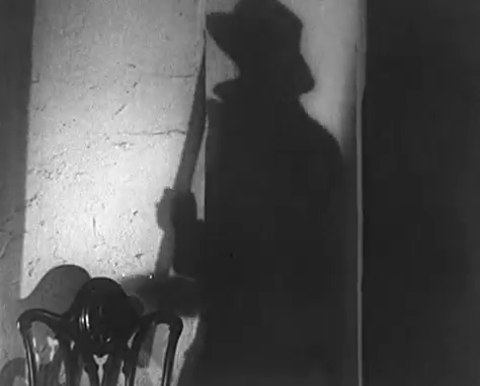
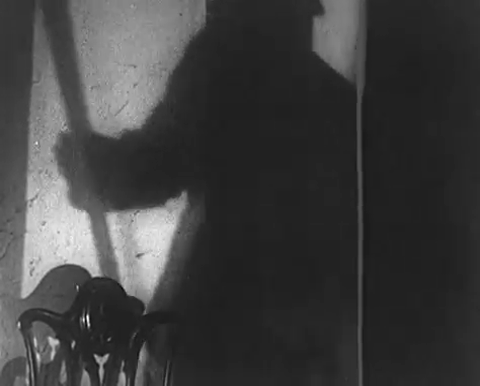

Must try and see this one. The cast looks good. Thanks for your review.
After I’d posted this, I was idly looking at one of the reviews linked from IMDB and was amused to see that the reviewer regarded it as his go-to Old Dark House movie!
Well, I’m convinced to give this a go and I’m not sure I would have otherwise – well done sir!
Hope you enjoy it! It’s a movie that seems generally to inspire an affectionate response.
The annoying part is, I think, way back when, that I may have seen it actually – but it is a bit easy to get confused with these (at least, for me it is).
Well, it’s only an hour if you find you’re watching it again. 🙂